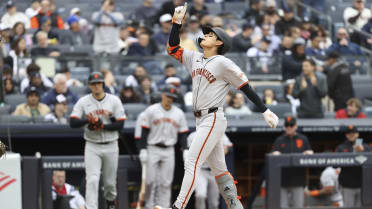LOS ANGELES -- Really, is there anyone who would know more about taking risks on the bases in the postseason than Dodgers manager Dave Roberts?
It's been more than 17 years since Roberts executed perhaps the most famous stolen base in baseball history, sparking the Red Sox to their remarkable 2004 American League Championship Series comeback against the Yankees.
Now Roberts is overseeing a team that takes those chances multiple times on a nightly basis -- though these Dodgers aren't quite so audacious. Their current stolen-base barrage is more calculated. The risk of L.A. baserunners being thrown out right now is low enough where it doesn't make sense not to go.
The Dodgers, simply put, are gambling in such a way that the odds are hugely in their favor every time they attempt a steal. Through eight postseason games, the Dodgers are 11-for-11 on stolen-base attempts, including six in two National League Championship Series games. They're the first team to steal multiple bases in three consecutive postseason games since 1999.
It's not just one player, either. Those 11 steals have come via five Dodgers. As a team, they're capitalizing on opposing pitchers by getting elite jumps. Against Atlanta, they’ve taken advantage of slower pop times from catcher Travis d’Arnaud.
With those statistical advantages tilted in their favor, the philosophy is more or less the same as it was for Roberts when he took off for second base at Fenway Park 17 years ago.
"In the postseason, where things are more magnified, you just can't be afraid to fail," Roberts said. "Careful, in the postseason, doesn't play. … You've got to be all in."
The Dodgers are. Their stolen-base success is simple: They're weighting the odds in their favor, then daring their opponent to do everything perfectly. Catch them if you can.
Let's dive into some of the data from each of their six steals in the NLCS. Most noteworthy:
• They've gotten better than average jumps on five of them. On the other, Trea Turner made up for it with an elite 30.2 ft./sec sprint speed.
• They’ve gotten better than average sprint speed on five of them. On the other, d’Arnaud had no chance to get Betts, then fumbled the ball on his transfer, allowing Betts to cruise into second base.
The average secondary lead on all steal attempts of second base this season -- meaning the distance of the runner from first base -- was 21.6 feet. The average sprint speed was 27 feet per second (with 30 ft./sec considered elite). Here are the Dodgers’ six steals in this series. Juxtaposed with the league averages, it's clear that the Dodgers are getting an advantage.
Second inning, Game 1: Chris Taylor
Sprint speed: 28.3 ft/sec (+1.3)
Secondary: 23.8 feet (+2.2)
Fifth inning, Game 1: Trea Turner
Sprint speed: 30.2 ft/sec (+3.2)
Secondary: 21.0 feet (-0.6)
First inning, Game 2: Gavin Lux
Sprint speed: 28.6 ft/sec (+1.6)
Secondary: 22.6 feet (+1.0)
Fifth inning, Game 2: Mookie Betts
Sprint speed: 25.7 ft/sec (-1.3)
Secondary: 26 feet (+4.4)
Sixth inning, Game 2: Chris Taylor
Sprint speed: 27.9 ft/sec (+0.9)
Secondary: 24.3 feet (+2.7)
Seventh inning, Game 2: Mookie Betts
Sprint speed: 27.1 ft/sec (+0.1)
Secondary: 26.6 feet (+5.0)
No wonder the Dodgers are running wild. Through two games in the NLCS, it hasn’t paid dividends, however, as Los Angeles is a mere 2-for-18 with men in scoring position. But the offensive struggles are part of the reason why the Dodgers are so eager to steal in the first place.
As Roberts noted, when facing elite pitching in the postseason, it’s harder than ever to build a rally through singles. But if you can swipe a bag, you can score a run without needing that third single. He pointed to the ninth inning of Game 1, when Ozzie Albies stole second on Dodgers reliever Blake Treinen, who hasn’t allowed three hits in an outing since April. That put Albies in scoring position for Austin Riley’s game-winning hit.
For so long, the smart analysis noted that it wasn’t prudent to steal bases. Why give away outs? Lately, however, teams have begun to work around that dogma. Stealing bases doesn’t have to mean “giving away outs” if you ensure that your chances of success are high enough.
“It's changed over the years, and I think in the right way -- in the sense that some of these arms that you're seeing, it’s hard to build an inning, and I say build an inning by getting consecutive hits to score a run,” Roberts said. “So if you can take a calculated risk like Albies did [on Saturday] it just increases your chances. … That’s just a smart baseball play.”
AJ Cassavell covers the Padres for MLB.com.




